16-26 March, 2023


| England and Scotland 16-26 March, 2023 |  
|
We arrived via Delta / Virgin Atlantic in Manchester. After quite a luxurious flight, we taxied to a far corner of the airport and had to climb down a roofing staircase and step onto a bus to get to the dilapidated, but currently remodeling, tiny terminal. We already knew our train to York was going to be a bit tricky (thanks to electronic ticketing and messaging). It wasn't only track repairs but an "industrial action" (i.e. strike) that led us first to the bus to Huddlesford station. An historic Victorian brick pile, the station was a bit tough but we caught the quick train to York after a couple of 15-20 minute "industrial" delays.Arriving at York, it was a short and lovely walk on clean cobbled streets to the beautiful Judges Lodging. It is a Grade 1 listed Georgian townhouse built in the early 1700's. We chose a very comfortable room (the old Doctor's Office) in this oldest part of the building, just one flight up on the internal Georgian staircase (the best example, they said, of such a thing in England). No elevators in this Grade 1 building but nothing here was a problem. Though we really want local cuisine when we travel, our own rural setting on the family farm leads us to something distinctly non-local: we had a fine Thai dinner takeout from a bustling, authentic restaurant right beside us.
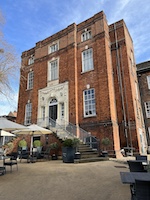
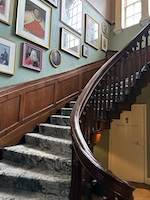
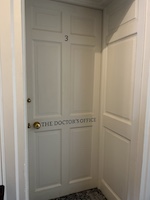
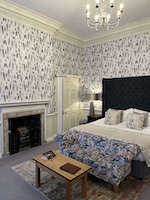
After a full English hotel breakfast in the cellar dining room, we walked a short way to Yorkminster Cathedral. The capable older man who was our docent gave a comprehensive one-hour tour pointing out the details of the stained-glass windows, including Jesus holding a baby bottle so as not to show any unnecessary Marian nudity. As with just about every such sacred sanctuary building in the world, Yorkminster has been built and rebuilt. In large part, we've come to York because of its old - really old - history. Indeed, Yorkminster was the site of the Roman Emperor Constantine's coronation in AD 306.


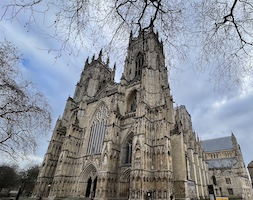

A beautiful approach The newest statue




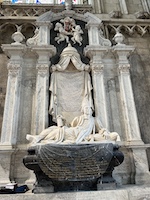





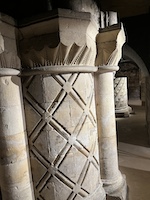
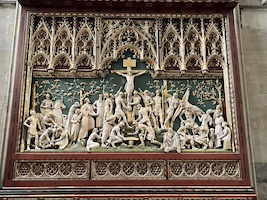
In the crypt Another tree-lined and short walk to the Merchant Adventurer's Hall for a self-guided tour. It's described this way: "The majority of the Hall was built in 1357 by a group of influential men and women who came together to form a religious fraternity called the Guild of Our Lord Jesus and the Blessed Virgin Mary. In 1371, a hospital was established in the undercroft for the poor people of York and, in 1430, the fraternity was granted a royal charter by King Henry VI and renamed 'The Mystery of Mercers'. It was granted the status of the Company of Merchant Adventurers of the City of York by Queen Elizabeth I in 1581." While there, an engaged couple was being led upstairs by an employee to plan their wedding reception and downstairs at least eight tables were filled with afternoon-tea patrons.

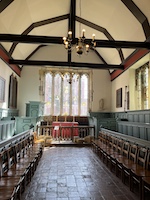
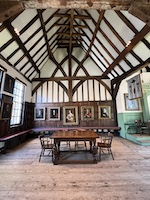
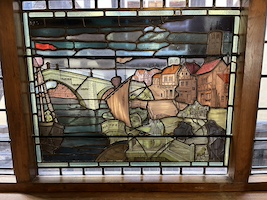
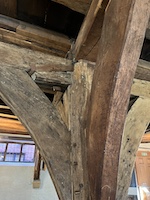
Next, upon the recommendation of our breakfast waitress, we went to the York Castle Museum on the site of York Castle - originally built by William the Conqueror in 1068. The museum itself was founded in 1938 and is housed in prison buildings which were built on the site of the castle in the 18th century, the debtors' prison (built in 1701-05 using stone from the ruins of the castle) and the female prison (built 1780-85). Many, many illuminating and, sometimes, disturbing displays across the facility, describing both the actual function of the building and reflecting on broader English life over the centuries. We looked at the daffodil-covered hill where the only remaining castle tower is open for touring and thought . . . Nah. Instead we had some coffee in the museum cafe and looked at others clambering up the hill.




Fine dinner was served at our hotel and we followed it by a riotous play, "Time Machine," at the York Theatre Royal. We had purchased the tickets several weeks prior and had - frankly - what we thought were the best seats in the house. The theatre itself is a classic venue, dating to 1744. This show, with a cast of only two men and one woman, is a take on the H.G. Wells story and quickly devolves into a display of actors' egos, imagined and real effects of time travel, and nothing but laughs. I expect this will make the rounds of smaller theatres across the U.S. as well if they can figure out how to make the inside jokes of current-day Britain work (yes, there was a bit of a Harry-to-Spare and Meghan reference).
Instead of renting a car on this trip, we'd decided on a number of day trips where someone else would do the driving. Our first small tour was in a 16-seat van with a capable guide/driver who offered many details on every location where we passed or stopped.First up, the 12th-century Byland Abbey built for 100 monks and 200 lay brothers. (The term Cistercian derives from Cistercium, the Latin name for the locale of Citeaux, near Dijon in eastern France.) The sign out front says Byland was probably the most ambitious Cistercian abbey built in England during this time and the church was larger than many contemporary cathedrals. The great western entrance is still clearly visible with the remains (on the right) of the west range of the cloister which would have contained storage cellars and the lay brothers' dormitory.
We are quite taken with this place, all alone and far from the city. It is good to be out in the dampish spring weather, such a far cry from the two feet of winter snow still on the ground at our Minnesota farm.
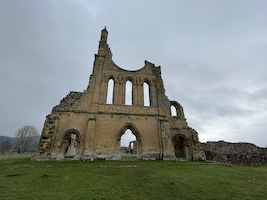

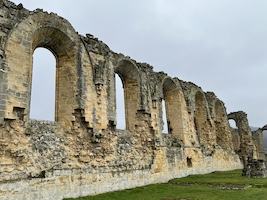
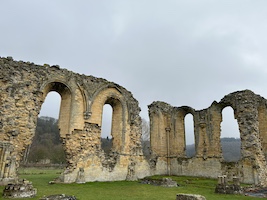


Helmsley was next. A thriving market town, archaeological discoveries indicate that the area around Helmsley was first settled in around 3,000 BC. The Norman Castle is our stop up here on the North Yorkshire moors. The drive is a bit reminiscent of the high-plateau feeling of the Jotunheimen in Norway.
Whitby is our main destination today, a harbor town formerly based on shipping traffic, now a much-loved and visited tourist destination. Situated on the east coast of Yorkshire, at the mouth of the River Esk, Whitby has a maritime, mineral and tourist heritage, becoming a tourist favorite in the 1800s. If you already know that by denotes the Norwegian word ending for a city, then it's quite easy to pick up on the fact that this northeastern town on the North Sea is going to have a Viking past as well.
The ruined abbey on the hill dates back to 656 AD with Roman ruins earlier than that in the vicinity. Whitby has also been famous for its trade in jet, carvings of which have been dated back to the Bronze Age. We do a bit of shopping but in the end decide on a millions-year-old fossil remnant to take back with us and we leave the jewelry behind.
There were a number of attractions that we lazily skipped: Whitby Abbey was Bram Stoker's inspiration for Dracula and the Captain Cook museum was in the captain's house. Instead we strolled among the seagulls and tourists and had a good fish and chips meal at one of many crowded, lines-out-the-door restaurants and pubs. One can only imagine what it's like in actual tourist season.
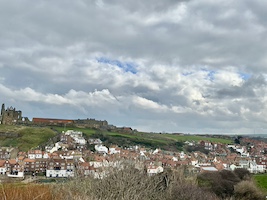
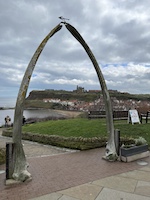

From the bus window The whalebone arch From the bench
Goodbye to Judges Lodging and a walk to York station with excellent train service to Glasgow after a short train change in Edinburgh. Our car was labeled "Coach K" and we rode through Durham, England today, which was apropos for Marisa. (She graduated from Duke University in Durham, NC, USA when legendary basketball coach Mike Krzyzewski, always known as "Coach K" first took over the Blue Devils there.)We would begin another bus tour for the week and our first stay was at the Maldron Hotel in Glasgow where we had dinner with other members of tour group, including a number of recently retired Wisconsin teachers at our table. As we know, having easy conversation can pass the time but we really didn't come to this part of the world to hang out with fellow Americans. Feels too much like getting off the Greyhound bus in Kentucky or something . . .
Out early and on our way to Stirling Castle. Marisa had finished up a 750-page book on Scottish history and the both of us had watched a 10-part BBC series on the history of Scotland before we left. We are prepared!Most of the principal buildings of the castle date from the fifteenth and sixteenth centuries but there are records as early as 1110 when King Alexander 1 of Scotland dedicated a chapel at the site. A few structures remain from the fourteenth century, while the outer defenses fronting the town date from the early eighteenth century. Stirling Castle is the site of many English-Scottish battles that went this way and that way and then back again. Several Scottish Kings and Queens have been born and died here; some have been crowned here including Mary Queen of Scots in 1542.
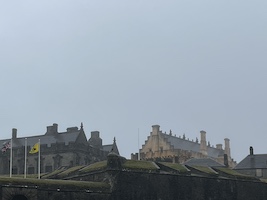

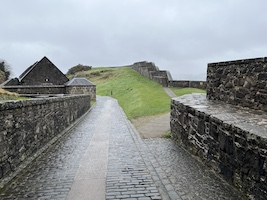



It pays to tour in off-season as we were the only ones in the room listening to a costumed musician play his lute for several minutes. No loud tour guides in multiple languages; no shuffling tourists; no whining children. And the gift shop had no lines! Marisa bought a locally woven scarf for her mother that was made of wool so fine that it feels like silk; a locally stitched tapestry cover for a pillow comes home with us.
And now the requisite distillery tour at Glengoyne. We've been to several of these - in the states where we've lived, in Ireland, and now for a wee dram in Scotland. Our guide was quick and funny; and of course, after our samples we purchased a few more for Wade.
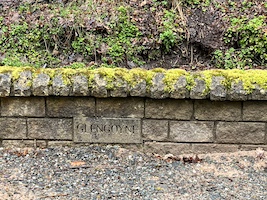
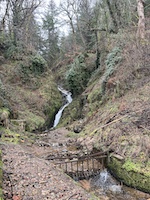
The whiskey had once used the clear water from the hill behind the distillery.
We ride for three relaxing hours from Glasgow to Inverness this morning with amazing views of mountains and fields and waters. Narrow country roads, high speeds and sharp curves have come to feel normal on this vacation. Marge's voice lulls us through tales of bloody Scottish history here in the Highlands.
We get out to stretch our legs near Glencoe - the "Weeping Glen" - where 38 members of the Clan MacDonald were killed in 1692 by soldiers of England's King William III. This was particularly treacherous as the MacDonalds had given these soldiers shelter for nearly two weeks before that fateful day. We tourists take note by stopping at a pretty little place for lunch and . . . shopping.


Loch Lomond near the village of Balmaha
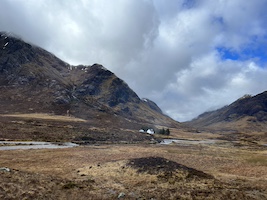
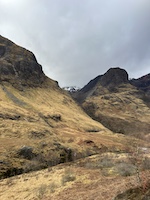

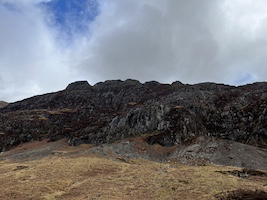
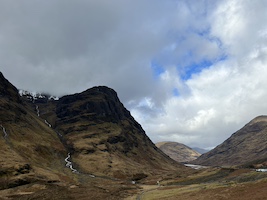

After unloading at a hotel right on the River Ness, we head out across the Caledonian Canal and on to the Clava Cairns. There are about 50 cairns of this type in an area round about Inverness and they typically have a corbelled passage grave, with a single burial chamber linked to the entrance by a short passage and covered with a cairn of stones, with the entrances oriented southwest towards midwinter sunset. Apparently, there are some Outlander references at this particular site for those familiar with that series. But us? No idea what they're talking about.



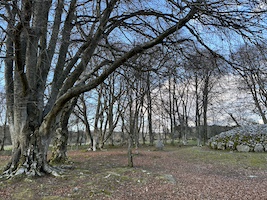
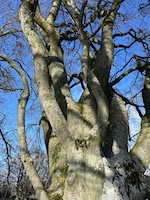
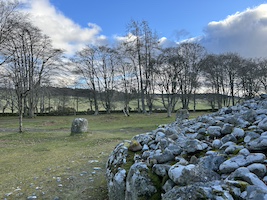
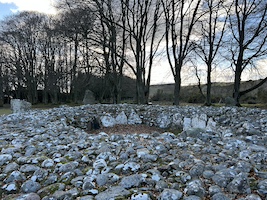

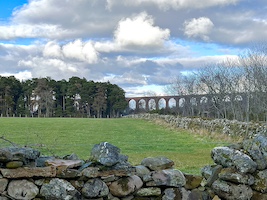
It's a peaceful evening out here among the Bronze Age ruins in the long afternoon shadows. And again, very few of us. The weather has been mostly sunny with just a few misty days. We hear many apologies for the weather, but we are loving these springlike days. Back to the hotel for pub conversation, dinner, and an early night with the windows wide open.
We begin our day with a stop at the Culloden Moor and a very well done visitor's center at the site of the final Battle of the Jacobite uprising in 1746. We are pleased again at having done some homework before arriving so that we can understand the place this has in the Highland psyche. (Americans, think Gettysburg except imagine it coming after hundreds of war years, not just three.)
This was, in fact, the last pitched battle fought on British soil. Lasting just one hour with "only" about 2,300 dead or wounded, it marked the end of the Scottish clan system as a military resource and the wearing of the tartan was banned except as part of a British military uniform. And Bonnie Prince Charlie eventually returns to France where he ends his days and becomes a tragic, romantic, legendary figure who is noo awa safely o'er the friendly main.
We drive now to Pitlochry for lunch. Largely a Victorian town, it developed into a tourist resort after Queen Victoria and Prince Albert visited the area in 1842 and bought their highland estate at Balmoral. It's a lovely little place and our lunch at Hettie's Tearoom was exactly right. We stroll and stroll, poke into little shops, try to blend in and pretend that huge bus 200 yards down the street doesn't belong to us.
Next up is St. Andrew's Golf Club, originally known as St Andrews' Mechanics Golf Club, was established in 1843 making it one of the oldest golf clubs in the world. It is windy and we can't quite figure out how the players are taking any sort of aim.It's not like we're there to play a round (!) so we do what makes sense: we find the club lounge with the distant view of a fairway but a great view of the beautiful shore. The gift shop had many items that would please Wade's golf-loving family.
Now great sheets of rain have joined the great gusts of wind as we make our way to Edinburgh. Because of major changes to busy streets of Edinburgh, with cabled trollies reintroduced in the last couple decades, even our seasoned bus driver was a bit put out with the detours. Though our hotel is a Marriott Courtyard property, it is an up-to-date facility reopened in 2017 that combines some older Georgian buildings with new structures as needed. We're pleased to be in good walking distance from the Royal Mile and right next door to the Edinburgh Playhouse.A modest, authentic Spanish restaurant is across the street, so we order takeout and eat back in the room. Ahhh . . .
Out with the tour group for our final day with them. Recognized as the capital of Scotland since at least the 15th century, Edinburgh is the seat of the Scottish Government, its parliament and the highest courts of Scotland. The city's Palace of Holyrood house is the British monarchy's official Scottish residence. The city has long been a center of education, particularly in the fields of medicine, law, literature, philosophy, sciences and engineering. Again, we are grateful for the BBC series on Scottish history that removed at least some of our ignorance.Edinburgh Castle was a walk-around visit, no guide, and we are impressed most with its sheer size. There has been a royal castle on Castle Rock since at least the 12th century and the site continued to be a royal residence until 1633. From the 15th century, the castle's residential role declined and by the 17th century it was principally used as military barracks with a large garrison. Research undertaken in 2014 identified 26 sieges in its 1,100-year history, giving it a claim to having been "the most besieged place in Great Britain and one of the most attacked in the world". Few of the present buildings pre-date the Lang Siege of the 16th century when the medieval defenses were largely destroyed by artillery bombardment. It was, indeed, a lang (long) siege of two years instigated by a switch of sides after Mary, Queen of Scots, was imprisoned in England.





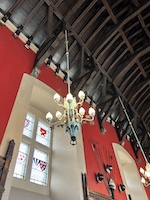
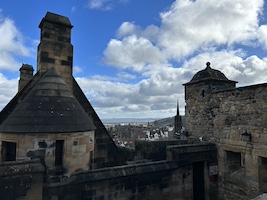
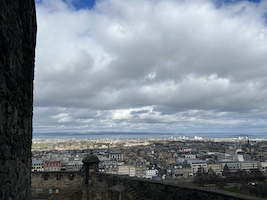

Constructed in the 12th century, St. Margaret's Chapel is the oldest surviving building in Edinburgh. She would never have worshipped here as it was built during David I's reign, her fourth son. Robert the Bruce destroyed all the building of the castle complex in 1314 but saved the little chapel and, on his death bed in 1329, issued orders and set aside 40 pounds for its repair.
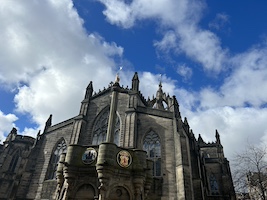
With an afternoon to ourselves, we head back down the Royal Mile for coffees, beers, shopping - the basics. Sitting outside in the coolish breeze, we hear the sound of bagpipes and immediately assume tourist trappings. But no! It's a wedding procession! Tough walking down that hill in high heels, thinks Marisa. . .
In late afternoon, we tour Her Majesty's (massive) Yacht Britannia, the former royal yacht of the British Monarchy in service from 1954 until 1997, the 83rd such vessel since 1660. During a 43-year career, the yacht travelled more than a million nautical miles around the world to more than 600 ports in 135 countries. Now retired from royal service, Britannia is a permanent floating museum that you get to by . . . walking through a mostly-empty shopping mall, up an elevator, and through the gift shop.While the sleeping and living quarters for family, guests and crew are interesting, the working rooms (post office, galley, engine rooms) make it real. A pretty comfortable English pub for the officers was, say the documents in the room, often visited by royalty of an evening. One can imagine that this was a welcome escape for those who were both so privileged and so constantly exposed to the public eye.
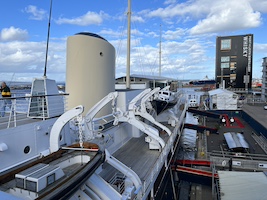


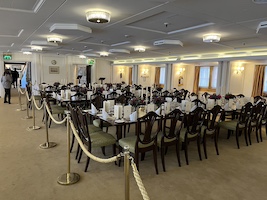


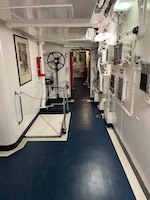

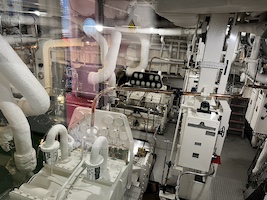
Since this was the final day of the bus tour, there was a dinner for all at a lovely restaurant near the water's edge. We chose a table for two and had a quiet evening of it.
A few goodbyes to some others, including to the guide, "Marge in Charge," as she called herself, and our driver, Alister. Generally, the bus tour served its purpose, and these two were professional, calm and competent.
Everyone else is leaving, but we will stay through the weekend.
This was our own walk-around day, the first since York, and we got lucky on the weather.
We purchased a one-hour walking tour of the Edinburgh Vaults, not really knowing what to expect. Interesting and shocking. The Edinburgh Vaults or South Bridge Vaults are a series of chambers formed in the nineteen arches of the South Bridge, completed in 1788. For around 30 years, the vaults housed taverns, workshops for cobblers and other tradesmen, as well as storage space.
In later years, the vaults were a hotspot for the homeless and for criminal activity such as illegal gambling taverns, illegal whisky distillery and - according to rumor - body snatchers (who actually existed in Scotland and sold these as cadavers to medical students and doctors alike) stored corpses there overnight.
Because of damp and poor air quality, the businesses left in the 1820s and the very poorest of Edinburgh's citizens moved in, though by around 1860, even they are believed to have left, too. That people had lived there was only discovered in 1985 during an excavation when toys, medicine bottles, plates, and other signs of human habitation were recovered.
Back up on the Royal Mile and we peek in and walk through several of the numerous small alleyways along the road. These narrow "closes" have been home to some of Scotland's most famous and influential figures whose homes were deeper off the Royal Mile. Because these passageways led to private residences, their entries were "closed" at night. As the Edinburgh population boomed in the 17th century, buildings were enlarged and what had been walking paths became these narrow alleys. As is often the case, the wealthy residents fled the cramped old town for "New Town" and the Closes became 19th-century slums. Many were demolished but many remain as landmarks, still named for those long gone residents.
Multiple stops for whatever we wanted whenever we wanted, including shopping, lunch and a drink. It is comforting to just be in a foreign city and make yourself at home.
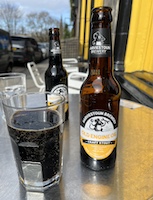
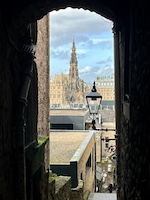
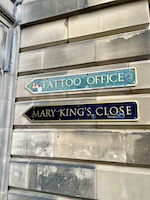
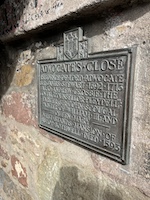
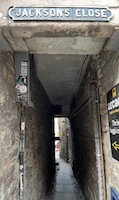
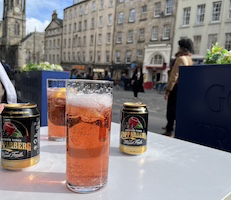
It's not really a Tattoo parlor.
On this day we take another of the small bus tours, guided by the driver who speaks into the mic as he drives. Not our favorite guide this time - quite silly speeches on high taxes and evils of urban society - but the sites and sights are worth the easy ride.
The first landmark is the statue of William Wallace. For not the first time, we are warned that the movie Braveheart was not historical, conflating Wallace and Robert the Bruce, messing about with timelines, and using the blue face paint of the Picts (the "painted people") who had been long gone by then. Wallace defeated an English army at the Battle of Stirling Bridge in September 1297 and was "Guardian of Scotland" for only one year, captured six years later and handed over to King Edward I of Scotland (the "Hammer of Scotland") who had Wallace hanged, drawn (intestines drawn out), and quartered (cut into bits). The statue was erected in 1814, more for tourists than for anything in particular in this area. Nice stretch of the legs, though, and we are tourists after all.
Next we're off to Melrose Abbey and we drive now on the roads well known by Sir Walter Scott (1771-1832) as he traveled to and from Abbottsford House, his nearby home.
The original 6th-century monastery was several miles east on the peninsula ("Mailros" in Old Welsh) neck of the River Tweed. It had already been abandoned in the 12th century when King David I wanted to revive it. The monks wanted this newer site instead and so the Abbey was built and the town grew up around it. The Abbey fell into ruin after the Reformation but is still a striking structure. Bits have begun falling off in the last several years, so we can't walk inside. That's fine, though, as it is the site that is lovely on this fine morning. Several Scottish nobles are buried here and apparently the heart of Robert the Bruce is in a small casket as well.
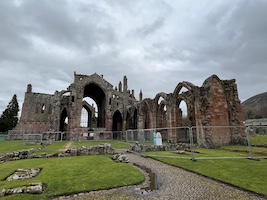
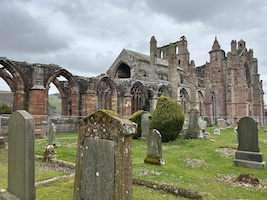
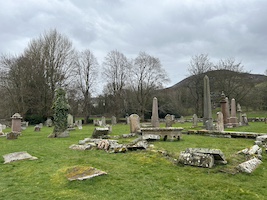
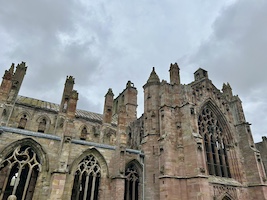

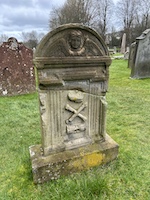
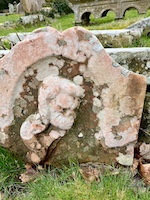

It's a relaxing ride now to Rosslyn Chapel, made recently famous again in the final scenes of The DaVinci Code. Now firmly on the tourist circuit, nobody is complaining at the site. In fact, there are references to quite a large donation by Tom Hanks to the new visitor's center.
Whatever one thinks about religious conspiracies and Hollywood, this is a beautiful chapel - inside and out. Timed tours, even at this time of year, are often sold out but we've managed to snag the last few spots and we race out of the doors to catch the tail end of our group as they head into the Chapel itself. The guide seats us and gives, frankly, a terrific 10-minute lecture on the history of the building. She strays only at the end into moviemaking. Now we wander at our leisure, snapping pictures of this unusually decorated site.
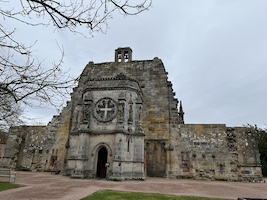

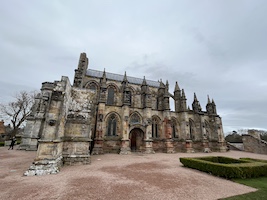

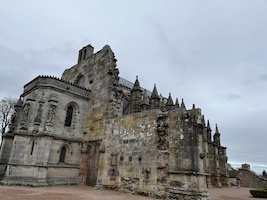

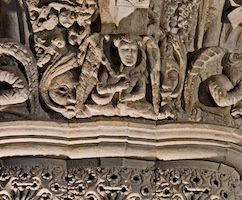
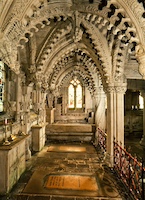

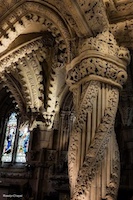


It is a relaxing ride back into Edinburgh, watching the sites go by, the driver blessedly quiet. Wade picks up a great Indian dinner from across the street and we eat in the hotel room. A bit tired of people and history, we watch ridiculous British game shows and think about how to pack up our loot for the plane ride home.
Our last day in Scotland begins on an easy Sunday morning and we have booked another day trip leaving from the very clean and intuitively signed bus station. The first stop is ostensibly to visit the Jedburgh Abbey, a 12th-century ruined Augustinian abbey in the Scottish Borders just 10 miles north of the border with England. Because of repairs and restoration, the abbey is closed to visitors so we decide to ditch the tour of the visitor center and head over to meet Mary, Queen of Scots, for the last time.Queen Mary's House is a 16th-century building that may have been where the Queen stayed for a few weeks in 1566. Nonetheless, it has been opened as a little museum since 1930. And it is very nicely done.
We pick up two coffees then stroll over to Murray's Green now and just sit to look at the sites of this small village.

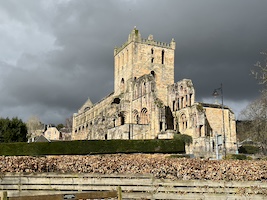
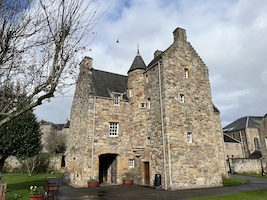
Jedburgh Abbey Queen Mary's House
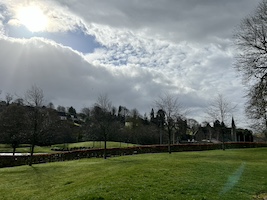
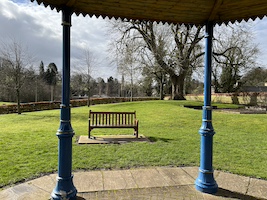
Murray's Green Back south into England now and the point of this day's excursion: Hadrian's Wall. Marisa had read several histories in her early years and teens, always vowing to see this place one day. Crossing back into England, the hills and mountains have a nice dusting of snow, giving us yet another excellent visual memory. Even though many erroneously think of Hadrian's Wall as the border between Scotland and England, it lies entirely within England and has never been any one of the several rather fluid borders between these two lands.


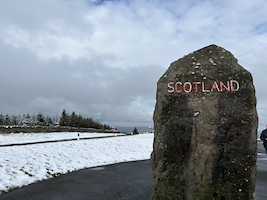
Hadrian's Wall, begun in 122 AD in the reign of the Roman Emperor Hadrian, crossed the entire width of England as the northern border fortification of the Roman Province of Britannia. Soldiers were garrisoned along the line in large forts and smaller "mile castles" (one mile equal to about seven English miles). Lots of turrets in between and gates that likely functioned as customs posts.
Our first stop to stretch our legs a bit is near Hexham. Our small group goes up and down, over and around, for about 45 minutes. It is a lovely day, the snow is gone, and it is good to be out.
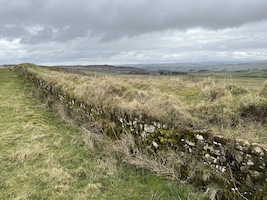


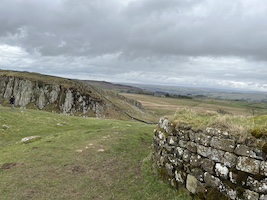
We stop at the Roman Fort of Vindolanda, occupied from about 85 AD to 370. The driver drops us off at the lower point where the little cafe (and bathrooms) are. We order a surprisingly good lunch and lounge about for a bit before heading up the long walk through the ruins and into the museum which is excellent. The whole site is quite a bit larger than I think we imagined and it's easy to get lost in thought about these soldier-occupiers at the far ends of their empire.
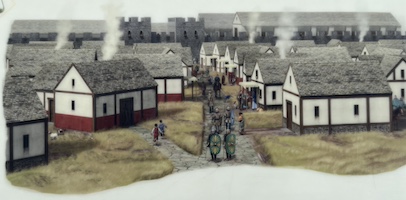
Then 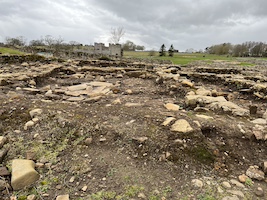



Now It's all about the driving now and this guide is excellent. We are about 12 people on his coach - Canadian, German, Dutch, American - and he offers a few options: hike a few miles one way to get a great view at the top of the hill or stroll a few hundred yards the other way to visit another excavated site at Birdoswald. Some go one way, some go another. We head to the other site and find another excellent visitor's center. They're ready to close quite soon so we spend the rest of our time in the courtyard with a hot cuppa lost in thought on our last day.
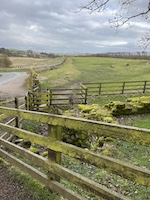

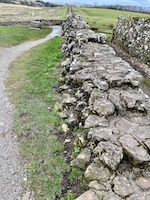
Scotland and the Yorkshire towns and countryside in England have given us even more connection to how our own home country was modeled after these - reimagined and redesigned over centuries - and remains unchangeably, culturally intertwined with them. Now we pull together our belongings and fresh memories and head off in a cab for an easy, uneventful return home, flying to Amsterdam and then nonstop to Minneapolis for our last, short leg on a small jet to Thief River Falls. We know we are fortunate to be able to travel and explore this way, and we both believe it is, therefore, our responsibility to do so as citizens of the world as well as of our native land.Here's to the next joyful expedition!